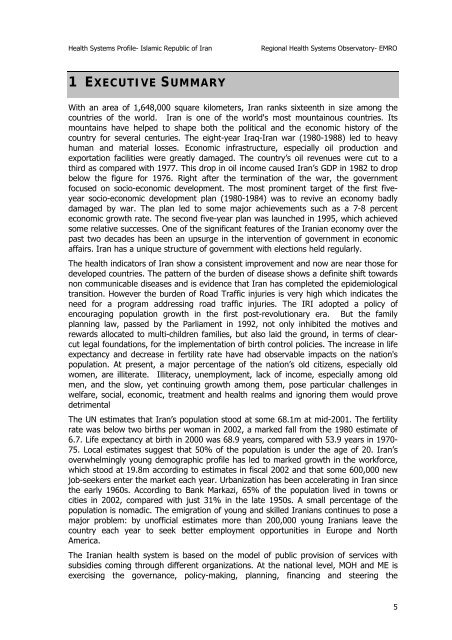Health system profile - Islamic Republic of Iran - What is GIS - World ...
Health system profile - Islamic Republic of Iran - What is GIS - World ...
Health system profile - Islamic Republic of Iran - What is GIS - World ...
Create successful ePaper yourself
Turn your PDF publications into a flip-book with our unique Google optimized e-Paper software.
<strong>Health</strong> Systems Pr<strong>of</strong>ile- <strong>Islamic</strong> <strong>Republic</strong> <strong>of</strong> <strong>Iran</strong> Regional <strong>Health</strong> Systems Observatory- EMRO<br />
1 EXECUTIVE SUMMARY<br />
With an area <strong>of</strong> 1,648,000 square kilometers, <strong>Iran</strong> ranks sixteenth in size among the<br />
countries <strong>of</strong> the world. <strong>Iran</strong> <strong>is</strong> one <strong>of</strong> the world's most mountainous countries. Its<br />
mountains have helped to shape both the political and the economic h<strong>is</strong>tory <strong>of</strong> the<br />
country for several centuries. The eight-year Iraq-<strong>Iran</strong> war (1980-1988) led to heavy<br />
human and material losses. Economic infrastructure, especially oil production and<br />
exportation facilities were greatly damaged. The country’s oil revenues were cut to a<br />
third as compared with 1977. Th<strong>is</strong> drop in oil income caused <strong>Iran</strong>’s GDP in 1982 to drop<br />
below the figure for 1976. Right after the termination <strong>of</strong> the war, the government<br />
focused on socio-economic development. The most prominent target <strong>of</strong> the first fiveyear<br />
socio-economic development plan (1980-1984) was to revive an economy badly<br />
damaged by war. The plan led to some major achievements such as a 7-8 percent<br />
economic growth rate. The second five-year plan was launched in 1995, which achieved<br />
some relative successes. One <strong>of</strong> the significant features <strong>of</strong> the <strong>Iran</strong>ian economy over the<br />
past two decades has been an upsurge in the intervention <strong>of</strong> government in economic<br />
affairs. <strong>Iran</strong> has a unique structure <strong>of</strong> government with elections held regularly.<br />
The health indicators <strong>of</strong> <strong>Iran</strong> show a cons<strong>is</strong>tent improvement and now are near those for<br />
developed countries. The pattern <strong>of</strong> the burden <strong>of</strong> d<strong>is</strong>ease shows a definite shift towards<br />
non communicable d<strong>is</strong>eases and <strong>is</strong> evidence that <strong>Iran</strong> has completed the epidemiological<br />
transition. However the burden <strong>of</strong> Road Traffic injuries <strong>is</strong> very high which indicates the<br />
need for a program addressing road traffic injuries. The IRI adopted a policy <strong>of</strong><br />
encouraging population growth in the first post-revolutionary era. But the family<br />
planning law, passed by the Parliament in 1992, not only inhibited the motives and<br />
rewards allocated to multi-children families, but also laid the ground, in terms <strong>of</strong> clearcut<br />
legal foundations, for the implementation <strong>of</strong> birth control policies. The increase in life<br />
expectancy and decrease in fertility rate have had observable impacts on the nation's<br />
population. At present, a major percentage <strong>of</strong> the nation’s old citizens, especially old<br />
women, are illiterate. Illiteracy, unemployment, lack <strong>of</strong> income, especially among old<br />
men, and the slow, yet continuing growth among them, pose particular challenges in<br />
welfare, social, economic, treatment and health realms and ignoring them would prove<br />
detrimental<br />
The UN estimates that <strong>Iran</strong>’s population stood at some 68.1m at mid-2001. The fertility<br />
rate was below two births per woman in 2002, a marked fall from the 1980 estimate <strong>of</strong><br />
6.7. Life expectancy at birth in 2000 was 68.9 years, compared with 53.9 years in 1970-<br />
75. Local estimates suggest that 50% <strong>of</strong> the population <strong>is</strong> under the age <strong>of</strong> 20. <strong>Iran</strong>’s<br />
overwhelmingly young demographic <strong>pr<strong>of</strong>ile</strong> has led to marked growth in the workforce,<br />
which stood at 19.8m according to estimates in f<strong>is</strong>cal 2002 and that some 600,000 new<br />
job-seekers enter the market each year. Urbanization has been accelerating in <strong>Iran</strong> since<br />
the early 1960s. According to Bank Markazi, 65% <strong>of</strong> the population lived in towns or<br />
cities in 2002, compared with just 31% in the late 1950s. A small percentage <strong>of</strong> the<br />
population <strong>is</strong> nomadic. The emigration <strong>of</strong> young and skilled <strong>Iran</strong>ians continues to pose a<br />
major problem: by un<strong>of</strong>ficial estimates more than 200,000 young <strong>Iran</strong>ians leave the<br />
country each year to seek better employment opportunities in Europe and North<br />
America.<br />
The <strong>Iran</strong>ian health <strong>system</strong> <strong>is</strong> based on the model <strong>of</strong> public prov<strong>is</strong>ion <strong>of</strong> services with<br />
subsidies coming through different organizations. At the national level, MOH and ME <strong>is</strong><br />
exerc<strong>is</strong>ing the governance, policy-making, planning, financing and steering the<br />
5

















